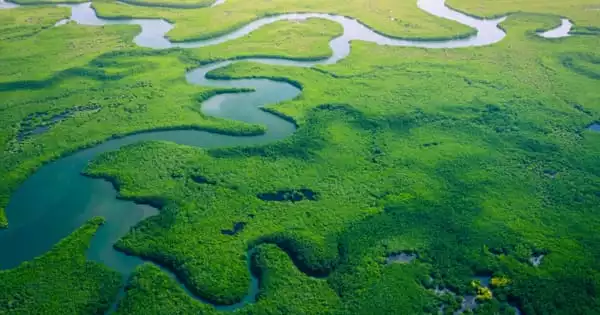According to an international study that included Rensselaer Polytechnic Institute researchers, current water quality guidelines are not safeguarding freshwater habitats from growing salt contamination caused by road de-icing salts, agricultural fertilizers, and mining operations. The study, which was published today in the Proceedings of the National Academy of Sciences (PNAS), shows that freshwater salinization causes a massive loss of zooplankton and an increase in algae – even when levels are within the lowest thresholds established in Canada, the United States, and throughout Europe.
“It is obvious that salt pollution in freshwater lakes, streams, and wetlands, even when limited to levels expressly set to safeguard the environment, endangers biodiversity and the overall operation of freshwater ecosystems. This is a global issue with the potential to harm ecosystems and human health “Rick Relyea, co-author of the paper and head of Rensselaer’s Darrin Fresh Water Institute, is an expert on the effects of road salt on freshwater ecosystems. “The good news, as we’ve seen in our own region, is that communities are learning how to use road salts more effectively while still delivering safe roads and saving significant money on snow and ice removal.”
Dr. Relyea, director of the Jefferson Project at Lake George and a member of the Rensselaer Center for Biotechnology and Interdisciplinary Studies, has undertaken considerable study on the effects of road salt on aquatic habitats. His research has contributed to the discovery that road salt masculinizes young frogs and destroys zooplankton’s circadian rhythm. Dr. Relyea has recently worked with an experimental network of 16 stations spread across four countries in North America and Europe. Dr. Relyea and that network published experimental findings earlier this year, led by Canadian scientist Marie-Pier Hébert, that suggest that lake salinization reduces zooplankton number and diversity.
Salt pollution from human activities, such as the use of road de-icing salts, is increasing the salinity of freshwater ecosystems to the point where the guidelines designed to protect freshwater aren’t doing their job.
Bill Hintz
The PNAS study, headed by The University of Toledo and Queen’s University in Kingston, demonstrates that even at salt concentrations below those deemed acceptable and protective of freshwater creatures by government regulators, significant damage is being done to freshwater lakes.
Increased salinity, in particular, threatens zooplankton, a crucial food supply for many young fish, and changes caused by rising salinity may disrupt nutrient cycling, water quality and clarity, and cause growth and population losses in commercially important fish species.
According to the researchers, the findings indicate a significant threat to the biodiversity and functioning of freshwater ecosystems, as well as the need for governments to reconsider current threshold concentrations to protect lakes from salinization caused by sodium chloride, one of the most common salt types that causes salinization of freshwater lakes.
“Salt pollution from human activities, such as the use of road de-icing salts, is increasing the salinity of freshwater ecosystems to the point where the guidelines designed to protect freshwater aren’t doing their job,” said Bill Hintz, author and co-leader of the project and assistant professor of ecology at The University of Toledo. “Our work demonstrates the ecological consequences of salinization and highlights the urgent need to examine and reduce existing chloride thresholds, as well as establish reasonable standards in countries where they do not exist, to safeguard lakes from salt pollution.”

The Environmental Protection Agency’s lowest chloride concentration standard in the United States is 230 milligrams of chloride per liter. It is 120 milligrams of chloride per liter in Canada. Throughout Europe, thresholds are generally higher. It can take less than a teaspoon of salt to pollute five gallons of water to the point that is harmful for many aquatic organisms.
Chloride concentrations between 50 and 200 milligrams per liter are categorized as “somewhat polluted by salts” in other nations, and concentrations between 200 and 400 milligrams per liter are classified as “moderately polluted by salts” in others. Throughout much of Europe, the drinking water guideline is 250 milligrams per liter.
However, as the study demonstrates, deleterious effects occur well below those limitations. Chloride concentration thresholds that caused a more than 50% decline in zooplankton were at or below the governments’ defined chloride thresholds at roughly three-quarters of the study sites. At nearly half of the study sites, the loss of zooplankton generated a cascading effect, resulting in an increase in phytoplankton biomass, or microscopic freshwater algae.
“More algae in the water could lead to a drop in water clarity, which could damage creatures living on the bottom of lakes,” said Shelley Arnott, professor of aquatic ecology at Queen’s University and project co-leader. “The loss of zooplankton, which results in increased algae, has the potential to affect lake ecosystems in ways that may change the services lakes provide, such as recreational opportunities, drinking water quality, and fisheries.”
The scientists chose to study zooplankton communities from natural habitats rather than single-species laboratory studies because this approach encompasses a greater diversity of species and naturally occurring predator-prey and competitive interactions within the zooplankton community over a six-to-seven-week time span.
The study aimed to learn more about how the chloride thresholds would fare in a more natural ecological situation. They wanted to know if current chloride-based water-quality criteria preserve lake creatures in varied geology, water chemistry, land-use, and species pools.
“Many salt-contaminated lakes with chloride concentrations near or over defined thresholds throughout North America and Europe may already have witnessed food web alterations,” Dr. Hintz added. “This is true for lakes all across the world, not just the research sites. Furthermore, the variety in our experimental results shows how new thresholds should account for the susceptibility of ecological communities at the local and regional levels. While official standards may safeguard freshwater creatures in some areas, this is not the case in many areas of the United States, Canada, and Europe.”
Finding strategies to strike a careful balance between human use of salt responsible for freshwater salinization and ecological implications, such as lowering the quantity of road salt used to melt winter snow and ice to keep people safe and traffic flowing, is also part of the solution. Dr. Hintz’s past research offers effective management methods.





